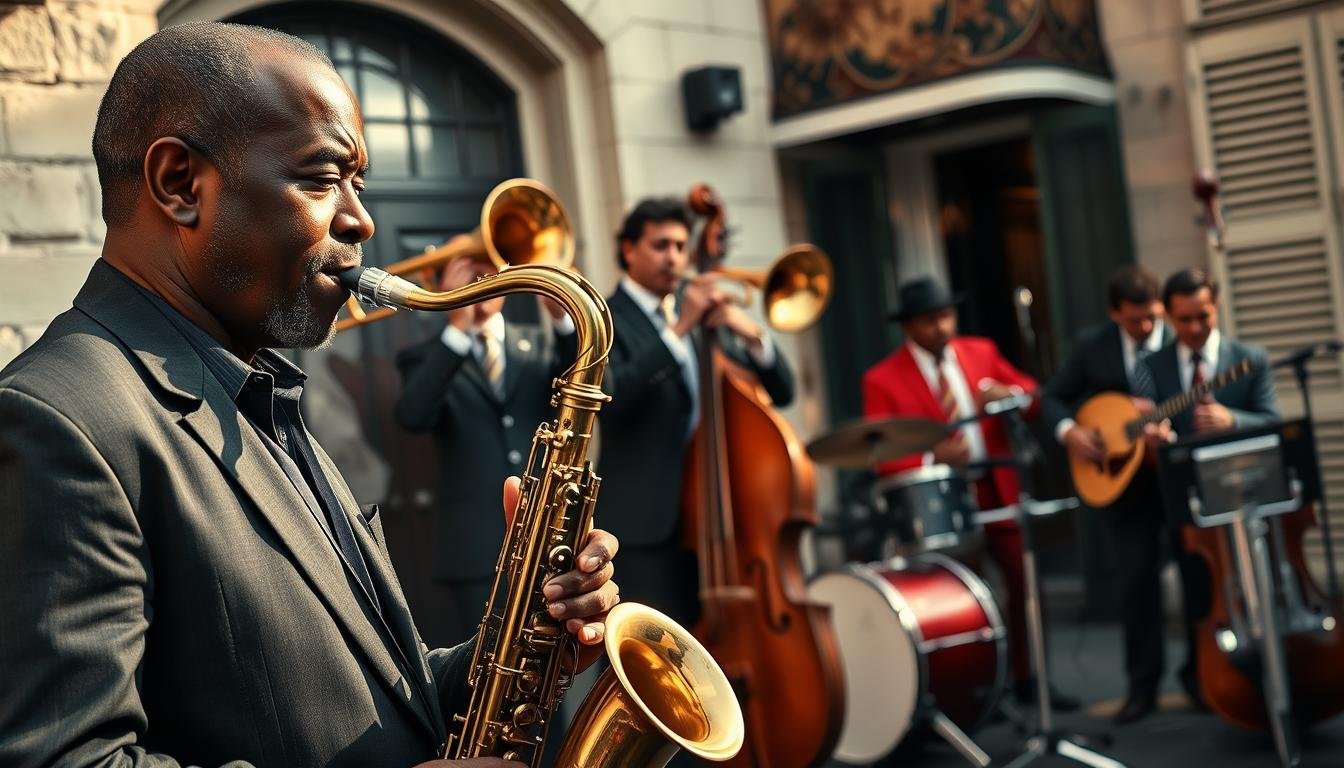Growing up in New Orleans, I’ve seen firsthand how the city’s jazz scene has evolved over the years, shaped by legendary musicians who’ve left an indelible mark on the music landscape.
From the early days of jazz to the modern era, artists like Louis Armstrong have not only influenced the genre but also become cultural icons, helping to define the city’s unique sound through timeless jazz standards.
As we explore the history of jazz in New Orleans, we’ll take a journey through the key figures who’ve made significant contributions to the music scene, shaping the sound that continues to inspire and captivate audiences today.
Key Takeaways
- New Orleans jazz has a rich history shaped by iconic musicians.
- Louis Armstrong is a cultural icon who influenced the genre.
- Jazz standards continue to define the city’s unique sound.
- The city’s jazz scene has evolved over the years.
- Legendary musicians have left a lasting impact on the music landscape.
The Origins of Jazz in New Orleans
The city’s unique blend of African, European, and Caribbean influences created a fertile ground for jazz to flourish. This cultural melting pot, combined with the city’s strategic location, made New Orleans a hub for musical innovation.
Key Historical Influences
Jazz in New Orleans was shaped by several key historical figures. Buddy Bolden, known for his charismatic stage presence, is often credited with creating the style that became known as jazz. His band was a staple in the city’s music scene, blending African rhythms with European instrumentation.
Another influential figure was Jelly Roll Morton, a pianist and composer who was one of the first great jazz musicians. Morton’s compositions and performances helped to formalize jazz as a distinct genre, paving the way for future generations of musicians.
Cultural Melting Pot Factors
The cultural diversity of New Orleans was a crucial factor in the development of jazz. The city’s African heritage contributed complex rhythms and improvisational elements, while European influences brought harmony and instrumentation. Caribbean rhythms also played a significant role, adding another layer to the city’s musical tapestry.
This blend of cultures created a unique musical environment where different traditions could merge and evolve. As a result, New Orleans became the birthplace of jazz, a genre that continues to be celebrated and innovated upon to this day.
Louis Armstrong: The King of Jazz
With his innovative trumpet playing and distinctive vocals, Louis Armstrong redefined the boundaries of jazz. Born in New Orleans, a city renowned for its rich musical heritage, Armstrong’s early exposure to jazz would shape his future and the future of the genre.
Early Life and Musical Roots
Louis Armstrong’s journey into jazz began in the city’s vibrant music scene. Growing up in a poor African American family, Armstrong found solace in music, particularly after being sent to a reform school where he learned to play the cornet.
Armstrong’s early career was marked by his time with various jazz bands, including those led by Kid Ory and Fate Marable. His unique talent quickly gained recognition, paving the way for his move to Chicago and later, New York.
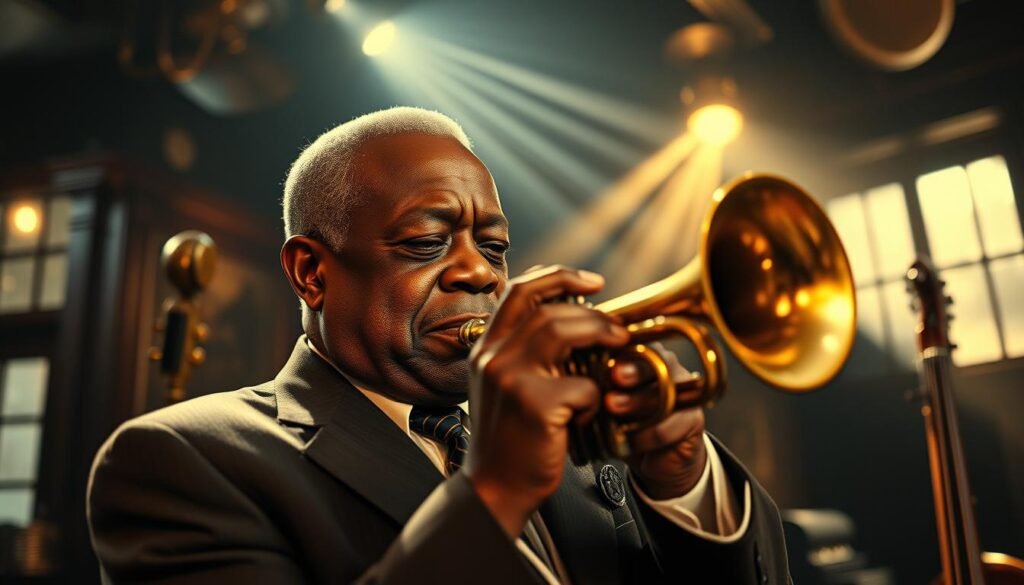
Impact on Jazz Standards
Armstrong’s impact on jazz standards was profound. He introduced a new level of expressiveness and intimacy to jazz singing, influencing generations of musicians to come. His rendition of “What a Wonderful World” remains one of his most beloved recordings.
Some of his most famous jazz standards include:
- “When the Saints Go Marching In”
- “West End Blues”
- “Potato Head Blues”
| Song Title | Release Year | Notable Feature |
|---|---|---|
| What a Wonderful World | 1967 | Iconic vocal performance |
| When the Saints Go Marching In | 1938 | Influential jazz standard |
| West End Blues | 1928 | Showcases Armstrong’s trumpet |
Lasting Legacy
Louis Armstrong’s legacy extends far beyond his own recordings. He paved the way for future generations of jazz musicians, from Miles Davis to Wynton Marsalis. His influence can be seen in various genres, including blues, pop, and rock.
Today, Armstrong is remembered not just as a talented musician but as a cultural icon who helped shape the sound of New Orleans and the world.
The Innovators: Modern Jazz Influencers
Wynton Marsalis and Terence Blanchard are among the modern jazz influencers who are keeping the spirit of New Orleans jazz alive. Their contributions to the genre are not only significant but also diverse, ranging from preserving jazz traditions to pushing the boundaries of what jazz can be.
Wynton Marsalis and His Contributions
Wynton Marsalis, a trumpeter and composer, has been instrumental in promoting jazz through his work with the Jazz at Lincoln Center Orchestra. His efforts have helped to educate audiences about the rich history and cultural significance of jazz. As Marsalis once said,
“Jazz is the ultimate expression of human freedom, and it’s got a lot to do with the history of America.”
This philosophy is reflected in his work, which often blends traditional jazz with modern elements.
Marsalis’s contributions can be seen in several areas:
- Preserving jazz standards through performances and recordings
- Commissioning new works that reflect the diversity of jazz
- Educating the next generation of jazz musicians through various programs
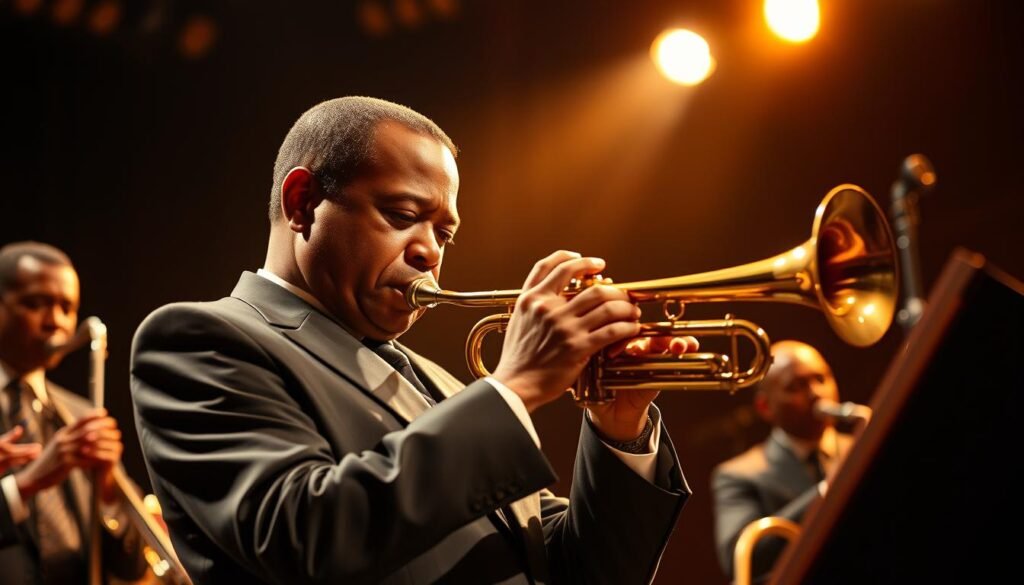
Terence Blanchard: Bridging Genres
Terence Blanchard, another influential figure in modern jazz, has made significant contributions by bridging genres. As a trumpeter and composer, Blanchard has worked on film scores, including collaborations with director Spike Lee. His ability to blend jazz with other styles has expanded the genre’s appeal and demonstrated its versatility.
Blanchard’s work on film scores has not only introduced jazz to new audiences but also brought a new level of sophistication to the genre. For instance, his score for BlacKkKlansman showcased his ability to merge jazz with contemporary themes. The impact of his work can be seen in the following table, which highlights some of his notable film scores and their critical reception.
| Film | Year | Critical Reception |
|---|---|---|
| Malcolm X | 1992 | Acclaimed for its powerful score |
| BlacKkKlansman | 2018 | Received critical acclaim for its innovative jazz score |
| Da 5 Bloods | 2020 | Praised for its emotional depth and jazz influences |
The work of both Wynton Marsalis and Terence Blanchard underscores the dynamic nature of New Orleans jazz, a genre that continues to evolve while remaining rooted in its rich cultural heritage.
Preservation Hall: A Jazz Institution
Deep within the heart of New Orleans’ French Quarter lies a revered venue that has been the guardian of traditional jazz for over six decades – Preservation Hall. This intimate hall, with its rich history and commitment to preserving the authentic sounds of New Orleans jazz, has become an indispensable part of the city’s cultural fabric.
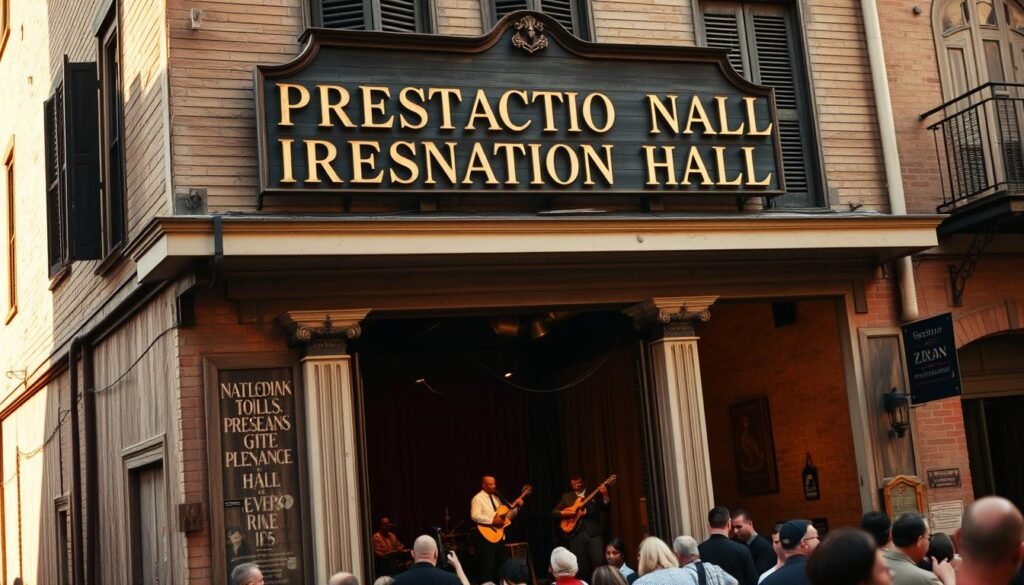
The Story Behind the Hall
Established in 1961 by Sandra and Allan Jaffe, Preservation Hall was born out of a passion to save traditional New Orleans jazz from fading into obscurity. The Jaffes, along with a group of local musicians and enthusiasts, worked tirelessly to create a space where the city’s jazz heritage could be celebrated and preserved.
The hall’s early days were marked by challenges, from finding the right location to gathering a community of supporters. However, the dedication of its founders and the community’s response turned Preservation Hall into a thriving hub for traditional jazz.
Role in Keeping Jazz Alive
Preservation Hall has played a pivotal role in keeping New Orleans jazz alive, not just by providing a stage for local musicians but also by fostering a global appreciation for this unique genre. The venue has hosted countless performances, featuring both seasoned legends and emerging artists, thus ensuring the continuity of the jazz tradition.
Moreover, Preservation Hall has been instrumental in promoting New Orleans jazz through various initiatives, including educational programs and tours that take the city’s jazz heritage to audiences worldwide.
Key Initiatives:
- Educational Programs: Workshops and classes aimed at preserving jazz traditions.
- International Tours: Showcasing New Orleans jazz globally.
- Community Engagement: Events and performances that engage the local community.
| Year | Event | Significance |
|---|---|---|
| 1961 | Establishment of Preservation Hall | Birthplace of a jazz institution |
| 1970s | First International Tours | Global promotion of New Orleans jazz |
| 2000s | Educational Programs Launch | Preservation of jazz traditions |
Through its unwavering commitment, Preservation Hall continues to be a beacon for New Orleans jazz, ensuring that this rich cultural heritage remains vibrant and alive for generations to come.
The Role of Festivals in Jazz Culture
Festivals are the lifeblood of jazz culture, and New Orleans is no exception, with the New Orleans Jazz & Heritage Festival being a prime example. This city’s rich musical heritage is celebrated through various events throughout the year, but the New Orleans Jazz & Heritage Festival stands out as a premier showcase for jazz talent.
The New Orleans Jazz & Heritage Festival, commonly referred to as Jazz Fest, is a celebration of the city’s music, culture, and community. It brings together local and international artists, offering a diverse range of jazz styles and influences. From traditional New Orleans jazz to modern fusion, the festival is a melting pot of sounds that reflect the city’s eclectic spirit.
New Orleans Jazz & Heritage Festival
The New Orleans Jazz & Heritage Festival is more than just a musical event; it’s an experience that embodies the city’s vibrant culture. With multiple stages featuring different genres, the festival is a testament to the city’s musical diversity. It’s not just about the music; it’s about the community that comes together to celebrate their heritage.
One of the key aspects of Jazz Fest is its ability to bring together both established and emerging artists. The festival provides a platform for musicians to showcase their talents, often leading to new collaborations and opportunities. It’s a place where tradition meets innovation, and where the past and present converge in the world of jazz.
The Importance of Music Communities
Music communities are the backbone of any thriving jazz scene, and New Orleans is no exception. The city’s jazz culture is deeply rooted in its communities, with numerous clubs, venues, and festivals that provide a nurturing environment for musicians. These communities are essential for preserving the city’s musical heritage while also fostering innovation and creativity.
The importance of music communities extends beyond the musicians themselves. They play a crucial role in shaping the cultural identity of the city, making New Orleans a unique and attractive destination for music lovers. By supporting local musicians and venues, these communities help to keep the jazz scene alive and vibrant.
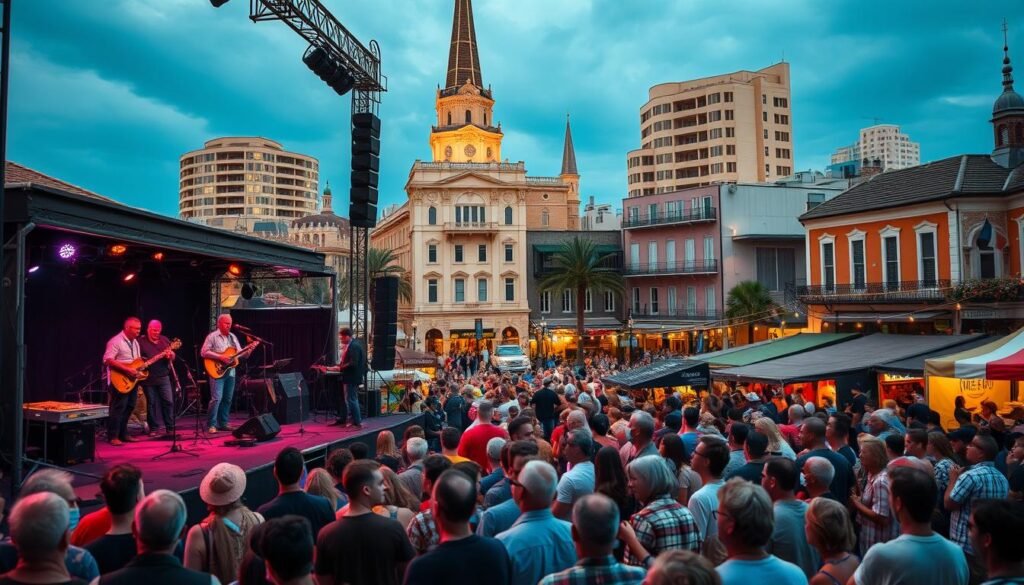
To illustrate the impact of festivals like Jazz Fest on the local music scene, let’s look at some key statistics:
| Year | Attendance | Number of Performers |
|---|---|---|
| 2022 | 90,000+ | 1,500+ |
| 2023 | 100,000+ | 1,700+ |
This data highlights the growing popularity of the New Orleans Jazz & Heritage Festival and its significance in the jazz community. As the festival continues to grow, it remains a vital part of the city’s cultural landscape, celebrating the rich heritage of New Orleans jazz.
Iconic Venues Where Jazz Comes Alive
In New Orleans, jazz isn’t just a genre – it’s a way of life, and the city’s iconic venues are where this culture comes alive. These legendary spots have hosted some of the biggest names in jazz and continue to be the heartbeat of the city’s music scene.
Tipitina’s: A Home for Legends
Named after Professor Longhair’s tune “Tipitina,” Tipitina’s has been a staple in New Orleans’ music scene since 1977. This iconic club has hosted legends like Harry Connick Jr. and Wynton Marsalis, making it a must-visit destination for jazz enthusiasts. With its lively atmosphere and rich history, Tipitina’s continues to be a hub for live music, showcasing both local talent and international acts.
The club’s commitment to preserving the city’s jazz heritage is evident in its regular performances and events. It’s not just a venue; it’s a cultural institution that keeps the spirit of New Orleans jazz alive.
The Spotted Cat Music Club: A Local Gem
For a more intimate jazz experience, The Spotted Cat Music Club is a cozy haven that has become a favorite among locals and visitors alike. This charming venue features a diverse range of acts, from traditional jazz to contemporary fusion, ensuring there’s something for every jazz aficionado.
The Spotted Cat’s warm atmosphere and dedication to showcasing emerging talent alongside established artists make it a unique gem in the New Orleans jazz scene. It’s a place where the community comes together to celebrate the city’s rich musical heritage.
Both Tipitina’s and The Spotted Cat Music Club are testaments to New Orleans’ enduring love affair with jazz. They provide a platform for musicians to perform, innovate, and connect with audiences, ensuring that the city’s jazz scene remains vibrant and dynamic.
Women in New Orleans Jazz
In the vibrant world of New Orleans jazz, women have been instrumental in defining its sound and spirit. From soulful vocalists to skilled instrumentalists, female musicians have contributed significantly to the genre’s evolution.
One contemporary voice making waves in New Orleans jazz is Angela Hunte. With her powerful vocals and genre-bending style, Hunte is carrying on the tradition of jazz greats while pushing the boundaries of what modern jazz can be. Her music is a testament to the enduring legacy of New Orleans jazz and its ability to adapt and thrive.
Angela Hunte: A Contemporary Voice
Angela Hunte’s journey in jazz is a story of passion and perseverance. With roots deeply planted in New Orleans, she has grown to become a respected figure in the jazz scene. Hunte’s performances are characterized by her rich, emotive voice and her ability to connect with audiences on a deep level. As she notes, “Jazz is about storytelling, and I’m honored to be part of that tradition.”
“Jazz is not just about the notes you play, it’s about the feelings you evoke.”
This quote encapsulates Hunte’s approach to jazz and highlights the emotional depth she brings to her performances.
The Influence of Legendary Women Musicians
New Orleans jazz has a rich history of legendary women musicians who have left an indelible mark on the genre. Mahalia Jackson, known as the “Queen of Gospel,” is one such icon whose influence extends into the jazz world. Her powerful voice and unwavering dedication to her craft have inspired generations of musicians. For more on influential women in jazz, visit The Jazz Arts Organization, which highlights the contributions of women who have shaped the genre.
The legacy of these women continues to inspire contemporary artists like Angela Hunte, ensuring that the spirit of New Orleans jazz remains vibrant and inclusive.
Legendary Duos and Collaborations
From Sidney Bechet to Louis Armstrong, collaborations have been at the heart of New Orleans jazz. The city’s jazz scene has long been fueled by the creative chemistry between musicians, resulting in some of the genre’s most iconic recordings.
Exploring Historic Partnerships
One of the most influential partnerships in early New Orleans jazz was between King Oliver and his protégé, Louis Armstrong. Their work together not only shaped Armstrong’s career but also contributed significantly to the development of jazz. As Armstrong once said, “Joe Oliver was the greatest. He was my idol.”
“Joe was the one who helped me get my first big break… He was like a father to me.”
This mentorship is a testament to the impact of collaborative relationships in jazz.
Another notable collaboration was between Sidney Bechet and Louis Armstrong. Although they worked together briefly, their combined talents produced some remarkable recordings. Bechet’s soprano saxophone and Armstrong’s trumpet created a unique sound that showcased the potential of jazz duos.
Collaborative Albums Worth Noting
Some albums stand out for their collaborative spirit. For instance, “Louis Armstrong and His All Stars” features a collection of talented musicians coming together to create timeless jazz. Another example is “Sidney Bechet: The French Sessions”, which highlights Bechet’s work with various musicians, showcasing the richness of collaborative jazz.
These albums are not just historical artifacts; they continue to inspire contemporary jazz musicians. The legacy of these legendary duos and collaborations can be seen in the work of modern artists who continue to push the boundaries of the genre.
The spirit of collaboration that defined the early days of New Orleans jazz continues to influence the genre today. As we look at the historic partnerships and albums that have shaped jazz, it’s clear that the magic of collaboration remains a vital part of the music’s enduring appeal.
New Orleans Jazz Today: A Vibrant Scene
As we explore the current state of New Orleans jazz, it’s clear that the city’s vibrant culture continues to inspire a new wave of talented musicians. The city’s jazz scene is a dynamic blend of tradition and innovation, where classic jazz standards meet modern influences.
The energy is palpable, with emerging artists bringing fresh perspectives to the genre. They’re not just preserving the legacy of jazz legends; they’re pushing the boundaries, experimenting with new sounds, and keeping the music alive.
Emerging Artists to Watch
New Orleans is nurturing a new generation of jazz talent, with musicians who are as comfortable with traditional jazz as they are with incorporating modern elements. Some of these emerging artists to watch include:
- Musicians who blend jazz with other genres like funk, rock, and hip-hop.
- Young trumpeters and saxophonists who are carrying on the tradition of Louis Armstrong and other jazz greats.
- Vocalists who are reinterpreting classic jazz standards with their own unique style.
| Artist | Instrument/Specialty | Notable Contribution |
|---|---|---|
| Ben Williams | Saxophone | Bringing a modern twist to traditional jazz |
| Lily Thorne | Vocalist | Reinterpreting jazz classics with a contemporary edge |
| Michael Rose | Trumpet | Leading a new generation of jazz musicians |
How Local Culture Shapes Modern Jazz
New Orleans’ unique cultural landscape plays a significant role in shaping its jazz scene. The city’s history, with its blend of African, European, and Caribbean influences, creates a rich musical heritage that continues to inspire musicians today.
The city’s jazz is characterized by its spontaneous energy, reflecting the improvisational spirit that is a hallmark of New Orleans culture. From the jazz funerals to the street performances in French Quarter, the city’s vibrant cultural scene is integral to its jazz identity.
As modern jazz continues to evolve, it’s clear that New Orleans’ cultural heritage will remain a vital force, shaping the sound of the city’s emerging artists and ensuring that its jazz scene remains as vibrant as ever.
The Future of Jazz in New Orleans
As we look to the future of jazz in New Orleans, it’s clear that the genre will continue to evolve, driven by the city’s rich cultural heritage. The legacy of legends like Fats Domino will continue to inspire a new generation of musicians, pushing the boundaries of jazz innovation.
The Ellis Marsalis Music Center, part of the Musicians’ Village in the Ninth Ward, is a testament to the city’s commitment to preserving its musical traditions. This vibrant community has become a hub for musicians, providing music lessons, meals, and homework help to children. As noted by Michael Harris, a bass player living in Musicians’ Village, the community plays a vital role in keeping New Orleans’ culture alive. For more on how New Orleans jazz is thriving, visit this article on the subject.
Balancing Tradition and Innovation
The future of New Orleans jazz lies in striking a balance between preserving the past and embracing innovation. By blending traditional jazz with modern styles, musicians are creating a unique sound that is both rooted in history and forward-thinking.
As the city continues to nurture its musical heritage, the new orleans jazz future looks bright, with emerging artists and established legends alike contributing to the genre’s ongoing evolution.
FAQ
Who are some of the most iconic jazz musicians from New Orleans?
New Orleans is the birthplace of many legendary jazz musicians, including Louis Armstrong, Jelly Roll Morton, Buddy Bolden, Sidney Bechet, King Oliver, Mahalia Jackson, Wynton Marsalis, and Fats Domino.
What is the significance of Preservation Hall in New Orleans?
Preservation Hall is a historic venue dedicated to preserving traditional New Orleans jazz. It has played a crucial role in keeping the genre alive and has become an iconic part of the city’s jazz scene.
How has New Orleans jazz evolved over the years?
New Orleans jazz has evolved through the contributions of various musicians, from the early days of jazz to the modern era. The genre has been shaped by the city’s unique cultural heritage and has incorporated influences from different styles and traditions.
What role do festivals play in promoting New Orleans jazz?
Festivals like the New Orleans Jazz & Heritage Festival play a vital role in promoting jazz culture and providing a platform for musicians to showcase their talents. They bring music communities together and help to keep the genre alive.
Who are some emerging artists in the New Orleans jazz scene?
The New Orleans jazz scene is constantly evolving, with new and emerging artists pushing the boundaries of the genre. Some artists to watch include those who are blending traditional jazz with modern influences and styles.
How has the city’s cultural heritage influenced the development of jazz?
New Orleans’ unique cultural heritage, shaped by African, European, and Caribbean influences, has had a profound impact on the development of jazz. The city’s strategic location and rich musical diversity have contributed to the genre’s distinct sound.
What are some iconic venues in New Orleans where jazz comes alive?
Iconic venues like Tipitina’s and The Spotted Cat Music Club are where jazz comes alive in New Orleans. These venues have hosted legendary musicians and continue to be an integral part of the city’s jazz scene.
How have women contributed to the New Orleans jazz scene?
Women have played a vital role in shaping the New Orleans jazz scene, from legendary musicians like Mahalia Jackson to contemporary vocalists like Angela Hunte. Their contributions have helped to enrich the genre and push its boundaries.
